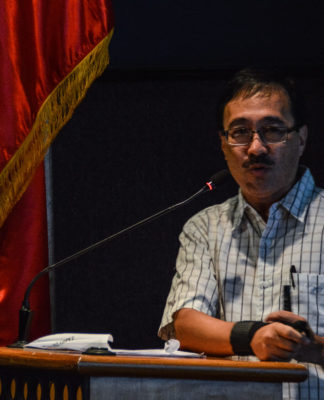 Questions have been raised by certain student leaders regarding the increase in the student publication fee, otherwise known as the Varsitarian fee, and the finances of the paper. This column will attempt to clear those issues.
Questions have been raised by certain student leaders regarding the increase in the student publication fee, otherwise known as the Varsitarian fee, and the finances of the paper. This column will attempt to clear those issues.
Let it be said in the outset that the Varsitarian is 83 years old and is the oldest Catholic campus paper in the country. Its longevity owes as much to its quality writing as to its effective operations and transparent dealings.
During the last academic year, at around January this year, the former editorial board, along with the publications advisers of the Varsitarian, decided to ask the administration for a 25-percent increase in publication fee primarily because of rising costs in printing, utilities, and operations. The request passed through the democratic process of consultation and dialogue. Although the last CSC leadership basically rejected the increase, the Varsitarian, since it is sovereign in itself and independent of the student government aside from being protected by the Campus Journalism Act, got its way: the student publication fee was increased from P120 to P150.
The raise was deemed essential so as to maintain quality standards as well as to cope with rising costs of editorial and extra-editorial activities.
Editorial activities refer to the publication operations, the Varsitarian being without a doubt, the country’s foremost campus paper. Extra-editorial activities refer to the special projects and programs undertaken by the paper.
Aside from the regular issues published by the paper fortnightly (every 15 days), the Varsitarian also comes up with a number of magazines, books, and special supplements. Early this year, for example, it came up with the celebrated Quadricentennial supplement, a full-color documentation of the opening of the UST Jubilee Year and other triumphant activities related to the start of UST quadricentenary. The supplement has become a collector’s item, with requests for copies coming even from abroad, so that the Varsitarian is thinking of reprinting it.
More quadricentenary-related publications will be released by the Varsitarian. The paper, for example, is set to release “400 Greatest Thomasians,” a massive book project that will identify top alumni across four centuries who best mirror Thomasian excellence. For everyone’s information, the research and work on this book have been going on for the last three years. The Varsitarian has tapped noted writers, editors, and artists, many of them the paper’s alumni, to undertake the project.
Also this year, the Ustetika literary folio, published every five years and gathers the winning entries of the Ustetika contest, and literary magazine “Montage,” will be released.
Also to be released is “Tomasino” (formerly titled Breaktime), the special Varsitarian magazine of alumni profiles and feature articles. Also this year, the Varsitarian will issue an updated edition of the Varsitarian Stylebook, which is used even by other campus papers and writers.
Aside from its publications, the Varsitarian also holds extra-editorial activities, which include the 34-year-old Pautakan quiz contest (the longest-running intercollegiate quiz contest in the country), the 27-year-old Ustetika literary awards (the most prestigious campus literary contest in the country), and the 13-year-old Inkblots national campus journalism fellowship, the largest of its kind. The paper has also been holding for several years now the campus-wide Fiction Workshop and the Cinevita educational film program.
Because of these meaningful and highly successful activities, groups in and out of the University have sought the help of the Varsitarian in planning and organizing their projects and programs that may dovetail with the Varsitarian’s vision and work. For example, the Philippine Center of the International PEN (Poets, Playwrights, Essayists, Novelists), founded by National Artist F. Sionil Jose and headed by National Artist Bienvenido Lumbera, both alumni of this paper, has periodically asked the Varsitarian to help it organize literary events, such as the PEN Writers Forum on Jose Rizal last July 30. The UST Department of Literature has also asked the Varsitarian to assist it in organizing—and funding—the Premio Tomas, the UST Quadricentennial literary prize.
For its quality publications and its cultural advocacy, for the many excellent writers and artists it has produced, the Varsitarian has been cited in the Cultural Center of the Philippines Encyclopedia of the Arts, the only campus paper to enjoy an entry.
All of this should show that the Varsitarian has been rendering quality service to Thomasian community. In short, the increase in the student publication fee is perfectly justified.
Students, campus leaders and school officials need not have qualms about the Varsitarian’s handling of funds as the paper files liquidation reports on all transactions with the UST Treasurer’s Office regularly. It is often complained about that the Varsitarian does not make a public accounting of its financial transactions. That is so because the paper does not keep its finances; its money is in the custodianship of the UST administration. It just makes requisitions and budget requests with the UST Treasurer’s Office and liquidates the same promptly.
During the democratic consultation regarding the Varsitarian’s request for a raise, the former CSC was shown the paper’s table of expenses and other financial data by the administration. If student leaders want to see the Varsitarian books, they’re available at the Treasurer’s Office.
The Varsitarian, under my watch, will continue to pursue a policy of openness and transparency. It will not reduce the quality of service it offers. It will continue to contribute to the honing of Thomasian excellence.















Do staffers of the Varsitarian get paid?
the staff, I believe — still receives honorarium for the work they render unto the paper … they used to receive scholarships but as this form of remuneration is not that equitable as some not-so-active members of the staff receive the same as their more gregarious counterparts, it was decided to convert staff benefits to honorarium or sort of “no work, no pay” policy.
however, be that as it may, the compensation the staff receives is a mere token incentive in order to recognize the time and energy they put into each issue.
I believe the increase in Varsitarian (publication) fee had been long overdue. It should’ve been implemented since the paper started to become fortnightly.
Students, and I am also calling the attention of student leaders, should not have qualms over the increase. The paper has been serving you more than what you have paid for. Every Thomasian needs to be aware of that.
Student leaders who opposed this increase in publication fee are obviously envious of this little “favor” granted to the Varsitarian. They have no idea that the student writers/photogs/artists/editors work HARDER than these leaders on the condition of constantly chasing deadlines while stretching muscle and bone to pass their subjects, and still produce a good quality publication or event with such professional execution often admired by other universities/colleges in the Philippines. I would say not a student body in the University has fared with the Varsitarian in terms of performance and relevance.